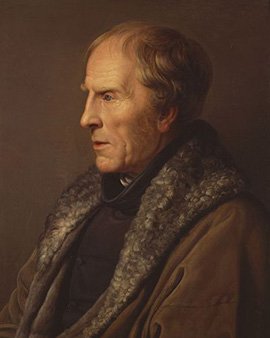Caspar David Friedrich gilt als einer der führenden Maler der deutschen Romantik. Er wuchs als sechstes von zehn Kindern im Greifswald auf. Seine Erziehung war vom streng lutherischen Glauben seines Vaters geprägt. Bereits in jungen Jahren musste Friedrich diverse Schicksalsschläge erleiden. Seine Mutter starb, als er 7 Jahre alt war. Kurz darauf starb eine seiner Schwestern. Im Alter von 13 Jahren musste er mit ansehen, wie sein ein Jahr jüngerer Bruder Christoffer im See ertrank. Christoffer war beim Versuch Caspar David zu retten, selbst ums Leben gekommen. Dieses Erlebnis prägte Friedrich stark und soll vermutlich einer der Gründe für seine spätere Depression und dem missglückten Suizidversuch gewesen sein.
Seine ersten Zeichenunterricht bekam Friedrich 1790 als Privatschüler des Künstlers Johann Gottfried Quistrop, der gerne Exkursionen mit seinen Schülern in die vorpommersche Landschaft unternahm. Er ermutigte Friedrich dazu frei aus der Natur zu zeichnen. Über seinen Lehrer Quistrop machte Friedrich auch die Bekanntschaft des Theologen Ludwig Gotthard Kosegarten, der die Natur als Offenbarung Gottes sah. Nach vier Jahren ging Friedrich zum Studieren an die Akademie Kopenhagen. Dort war er unter anderem Schüler von Christian August Lorentzen und Jens Juel. Nach Abschluss seines Studiums ließ sich Friedrich 1798 in Dresden nieder. Obwohl er sich in vielen verschiedenen Methoden probierte, wie Radierungen und experimentelle Drucke, zeichnete und malte er bevorzugt mit Tinte, Aquarell oder Sepia. Später malte er auch häufiger Ölgemälden. Häufige Motive seiner Arbeit waren Landschaftszenen, die von seinen häufigen Reisen an die Ostsee, nach Rügen oder in den Harz inspiriert waren. Bekanntheit erlangte er 1805, als er den begehrten Weimarer Kunstfreunde Preis, auf drängen von Goethe, gewann. Besondere Anerkennung findet sein Werk „Tetschener Altar“ (1807), was als Beginn seiner ausgereiften Öltechnik gilt.
Friedrichs Ruf verschlechterte sich in den letzten fünfzehn Jahren seines Lebens stetig. Als die Ideale der frühen Romantik aus der Mode kamen. Sahen ihn Zeitgenossen als eine exzentrische und melancholische Person. Sein Stil war nicht mehr zeitgemäß. Allmählich verließen ihn seine Gönner und Friedrich zog sich immer weiter zurück. Um 1835 erlitt er den ersten Schlaganfall, der erste Lähmungserscheinungen zur Folge hatte. Trotz eines Kuraufenthalts regenerierte sich Friedrich kaum und das Malen fiel ihm schwer. Er gab die Ölmalerei fast vollständig auf und widmete sich Aquarellen und Sepia-Zeichnungen. Sein letztes Ölgemälde war „Meeresufer bei Mondschein“. Die Werke aus dieser Zeit zeigten kaum noch Landschaftszenen, sondern enthielten häufig Symbole für den Tod und das schwindende Leben, wie „Sarg am Grab“. Friedrich konnte immer weniger malen und noch seltener verkaufen, wodurch er und seine Familie am Ende in Armut lebten.
×





.jpg)
.jpg)
.jpg)
.jpg)
.jpg)
.jpg)
.jpg)
.jpg)
.jpg)
.jpg)
.jpg)
.jpg)
.jpg)
.jpg)
.jpg)
.jpg)
.jpg)
.jpg)
.jpg)
.jpg)
.jpg)
.jpg)
.jpg)
.jpg)
.jpg)
.jpg)
.jpg)
.jpg)
.jpg)
.jpg)
.jpg)
.jpg)
.jpg)
.jpg)
.jpg)
.jpg)
.jpg)
.jpg)
.jpg)
.jpg)
.jpg)
.jpg)
.jpg)
.jpg)
.jpg)
.jpg)
.jpg)
.jpg)
.jpg)
.jpg)
.jpg)
.jpg)
.jpg)
.jpg)
.jpg)
.jpg)
.jpg)
.jpg)
.jpg)
.jpg)
.jpg)
.jpg)
.jpg)
.jpg)
_-_(MeisterDrucke-109470).jpg)
_-_(MeisterDrucke-109470).jpg)
.jpg)
.jpg)
.jpg)
.jpg)
.jpg)
.jpg)
.jpg)
.jpg)
_Peinture_de_Caspa_-_(MeisterDrucke-1325290).jpg)
_Peinture_de_Caspa_-_(MeisterDrucke-1325290).jpg)
.jpg)
.jpg)
.jpg)
.jpg)
.jpg)
.jpg)
.jpg)
.jpg)
.jpg)
.jpg)
.jpg)
.jpg)
_-_(MeisterDrucke-1090931).jpg)
_-_(MeisterDrucke-1090931).jpg)
.jpg)
.jpg)
_Peinture_de_-_(MeisterDrucke-1325288).jpg)
_Peinture_de_-_(MeisterDrucke-1325288).jpg)
.jpg)
.jpg)
.jpg)
.jpg)
.jpg)
.jpg)
.jpg)
.jpg)
.jpg)
.jpg)
.jpg)
.jpg)
.jpg)
.jpg)
.jpg)
.jpg)
.jpg)
.jpg)
.jpg)
.jpg)
.jpg)
.jpg)
.jpg)
.jpg)
.jpg)
.jpg)
.jpg)
.jpg)
.jpg)
.jpg)
_-_(MeisterDrucke-1080847).jpg)
_-_(MeisterDrucke-1080847).jpg)
.jpg)
.jpg)
.jpg)
.jpg)
.jpg)
.jpg)
 - (MeisterDrucke-99716).jpg)
 - (MeisterDrucke-99716).jpg)
.jpg)
.jpg)
.jpg)
.jpg)
.jpg)
.jpg)
 - (MeisterDrucke-55332).jpg)
 - (MeisterDrucke-55332).jpg)
.jpg)
.jpg)
.jpg)
.jpg)
.jpg)
.jpg)
.jpg)
.jpg)
.jpg)
.jpg)
.jpg)
.jpg)
.jpg)
.jpg)
.jpg)
.jpg)
.jpg)
.jpg)
.jpg)
.jpg)
.jpg)
.jpg)
.jpg)
.jpg)
.jpg)
.jpg)
.jpg)
.jpg)
.jpg)
.jpg)
_1835-40_(oil_on_canvas)_-_(MeisterDrucke-907503).jpg)
_1835-40_(oil_on_canvas)_-_(MeisterDrucke-907503).jpg)
.jpg)
.jpg)
_-_(MeisterDrucke-1427633).jpg)
_-_(MeisterDrucke-1427633).jpg)
_-_(MeisterDrucke-686408).jpg)
_-_(MeisterDrucke-686408).jpg)
.jpg)
.jpg)
.jpg)
.jpg)
.jpg)
.jpg)
.jpg)
.jpg)
.jpg)
.jpg)
.jpg)
.jpg)
.jpg)
.jpg)
_-_(MeisterDrucke-1427635).jpg)
_-_(MeisterDrucke-1427635).jpg)
.jpg)
.jpg)
.jpg)
.jpg)






